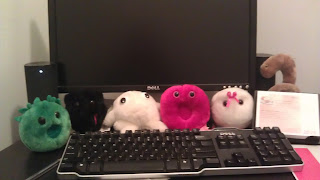April 29th marks the 8th annual Day of Immunology. It was started in 2005 by the European Federation of Immunological Societies to “strengthen public awareness of immunology as a basis for individual health and well-being”. Almost every time I tell people that I’m studying immunology they have no idea what that means. Since immunology is pretty freakin’ awesome, the Day of Immunology was started to teach the public about what we do. It’s a worldwide event with outreach activities in Europe, North America and Asia. The immunology research group at my university arranged outreach activities at 4 local elementary schools, and I was a team leader and ran a workstation yesterday. I had a lot of fun, and the kids were really interested!
Our session started with a talk about what microbes are. We had a bunch of the giant microbe stuffies that the kids got to check out and share fun facts from the info tags (that’s my collection below – Chlamydia, HIV, white blood cell, red blood cell, egg cell and Ebola(L-R)). Then I gave a talk about all the different kinds of microbes that exist – viruses, bacteria, parasites and fungi. Not all microbes are “bad”, so I made sure to emphasize the good and bad types from each group. I had an argument with one of the professors if there are any viruses that are good – she said no and I said yes. There is this one virus, called gB virus C, that is thought to be good for people that are infected with HIV. People that have HIV and gB virus C remain healthy longer than those people that have HIV and don’t have gB virus C. The virus doesn’t seem to have any effects in healthy people. That makes it a good virus in my books, but she thinks there must be something it does that’s bad that we just don’t know about. Bacteria and parasites/fungi were easier. Bacteria are used to make yogurt and our intestines, mouths, skin etc are covered with bacteria that help keep us healthy. We use yeast to make bread and beer, and penicillin is produced by a fungi. Microbes are everywhere, and they usually are good for us, but some are dangerous, which is why we need protectors.
Our protectors are diverse and have specific roles in keeping us healthy. The first line of defense is the natural barriers. This would be things like skin or mucus that can prevent microbes from actually entering the body. If a microbe passes through the natural barriers, like through a skin, then it encounters the innate immune system. The innate system recognizes pathogen associated molecular patterns (PAMPs), which are commonly expressed on pathogens but not on human cells. A special type of white blood cell called a macrophage patrols the body looking for pathogens. When the macrophage encounters a pathogen it “eats” it. The macrophage, and another type of cell called a dendritic cell, identify any invaders, then travel to lymph nodes (which swell when you’re sick) where they tell the adaptive immune system that there’s an invader. The adaptive immune system contains cells called T cells and B cells. There are a couple different types of T cells. The CD8+ T cells are killers - once they are turned on they go around the body and kill any cells (and only those cells) that are infected with the pathogen. The CD4+ T cells are helpers - they activate the B cells. The B cells produce antibodies which help in the immune response, by increasing efficiency of different immune processes. After the pathogen has been destroyed, T regulator cells turn off the activated T cells. T and B memory cells “remember” the pathogen that they’ve seen so they will react faster if it’s seen again, meaning you won’t get sick at all, or have a much milder case. This is why you only have the chicken pox once. This is also the basis of vaccination – you expose the immune system to a non-harmful “dose” of the pathogen to mimic infection, and your immune system remembers it, so you don’t get sick if you ever encounter the real pathogen. If enough people get vaccinated then you can eradicate a pathogen (like smallpox!).
After the talking bit we split the kids into 2 groups. One group looked at plates of bacteria that we had grown before coming to the lab. We had swabs taken from inside shoes, a piece of hair, cheek swabs, plant water, computer keyboard and lots of other common places. Each plate grew a lot of bacteria, which is kind of gross if you think about it, but bacteria are all around us! The station I was manning was teaching them how to make the plates. I explained how we grow bacteria in the lab and then sent them around the library armed with swabs to set up their own plates to see what grew. One group of boys went to the bathroom and swabbed inside the urinal . . . gross! We brought the plates back to the lab to grow for them, and then will send pictures back to the class.
During all this I was secretly “contaminated” with a glowing (not harmful) germ. It was all over my hands and on the water tube, and could be spread by touching surfaces. You could only see if with UV light, so we checked all the kids after to see who got my “germs”. Almost all the kids had some glowing spots on their hands. With the grade 4/5 class they wanted to keep shaking my hands to see if they could get infected. It was a really effective way to illustrate how easy a cold could spread, and that you need to wash your hands.
It was a lot of fun going to the school, and the kids seemed to enjoy it. Yay Immunology!
C
